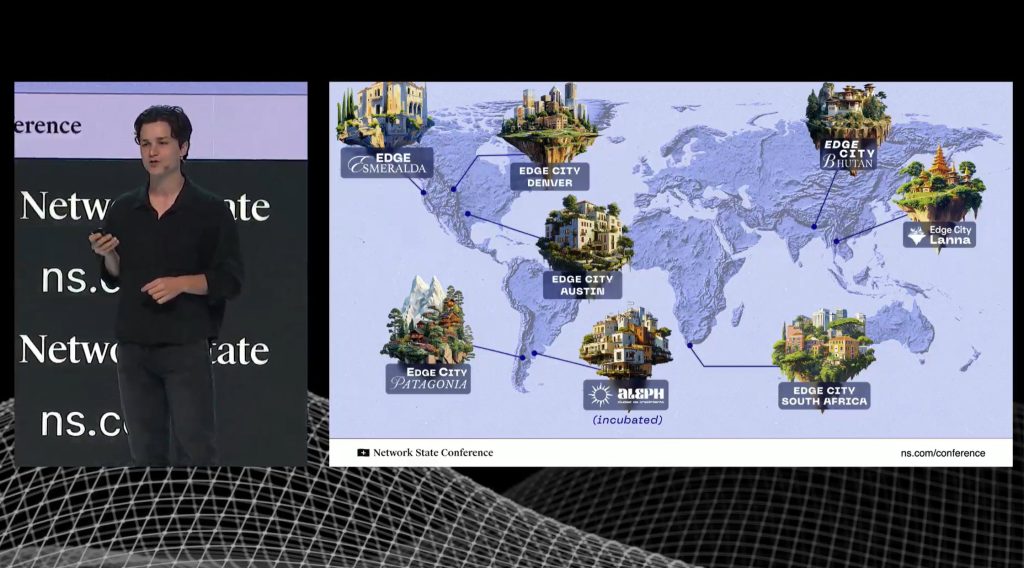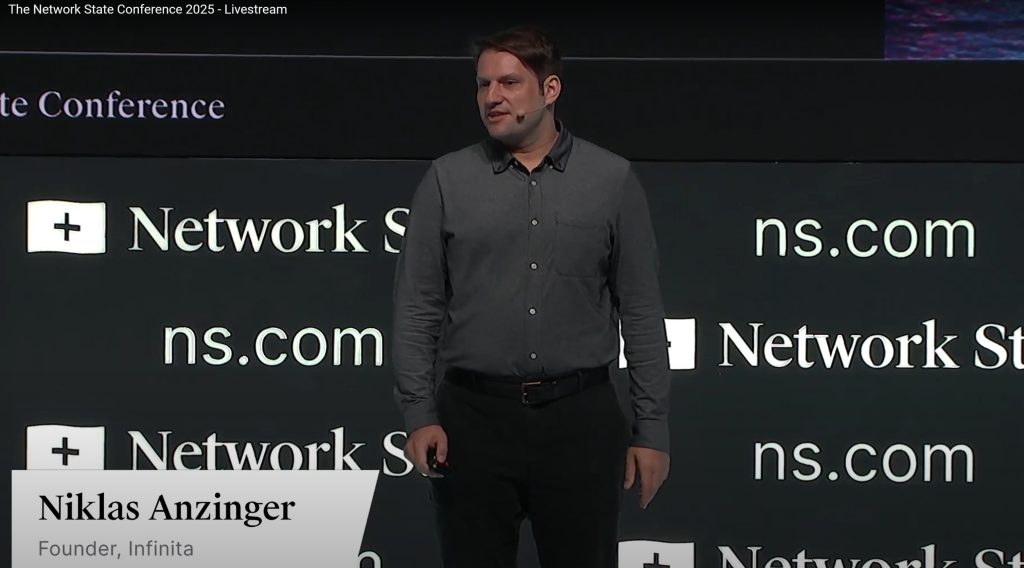Here @ Future Villages, we’re dedicated to crafting autonomous, affordable, and regenerative communities that harmonize technology with nature. This year, we attended the Network State Conference 2025 in Singapore—a visionary gathering exploring the next frontier of human organization: network states. Inspired by Balaji Srinivasan’s 2022 book The Network State, these digital-first communities bootstrap physical territories, leveraging blockchain, AI, and global collaboration to create opt-in societies unbound by traditional borders.
Held in Singapore, the conference united builders, innovators, and leaders like Ethereum’s Vitalik Buterin, Coinbase CEO Brian Armstrong, and longevity pioneer Bryan Johnson. It was less a conference and more a blueprint for reimagining society. For the Future Villages Team, it sparked ideas on how network state principles can enhance our mission to build regenerative, nature tech communities. Here’s our recap of key insights, actionable takeaways, and how we plan to weave these ideas into our vision.
The Dawn of Network States: From Digital Dreams to Physical Realities
Balaji opened with a timeline: From his 2022 book to the first public event in Amsterdam (2023), the launch of Network School on a Singaporean island (2024), and now a global movement in 2025. “Startup societies are emerging worldwide,” he said, showcasing projects like Edge City, Infinita, and Solana Economic Zones—communities building real-world cities, schools, and economies.
The conference featured in-depth spotlights on startup societies, each offering unique blueprints for blending digital innovation with physical presence. Farhaj from Forma detailed Solana’s pop-up villages in Kazakhstan and Georgia. In Kazakhstan, a one-day summit led to a government partnership, launching the nation’s first Solana Economic Zone. “We signed MOUs, trained 1,000 developers, and sparked a crypto reserve,” Farhaj noted, driving $5 million in investment and 10 million X impressions. For us, this inspires hosting “pop-up” tech events in our regenerative villages, blending local sustainability with blockchain for transparent supply chains.

Timour Kosters of Edge City described their month-long villages as “the highest leverage months of your year.” With principles like “default healthy” (nature, exercise) and “multi-generational” (150 kids at events), they’ve incubated startups like Constellation (neuroscience, funded in 30 days) and supported DAOs with Vitalik. Their October 2025 Patagonia event—a crypto-native town with saunas and hikes—shows what’s possible.
Niklas Anzinger from Infinita City pitched the “longevity network state,” a hub in Prospera, Honduras, for biotech acceleration. “We’ve funneled $20M to 100+ startups, including gene therapies for the Kardashians,” he said, highlighting Montana’s “right to try” laws and their LIVES token for island payments. Their 2026 Infinite Games—featuring electric knife fighting and rejuvenation Olympics—promise a “city that never dies.”

Isla from Zwitzerland unveiled a permanent village and accelerator for DeFi and open-source tech, inspired by Vitalik’s techno-optimism. “We’re building a Schelling point for $100B companies where purpose meets profit,” she said, partnering with resorts for onchain economies.
Vit from the Free Republic of Liberland shared their 10-year quest for a blockchain-governed micronation between Croatia and Serbia. With 1,300 citizens from 800,000 applicants, their Rust-based DAO blends meritocracy, democracy, and monarchy. “We’re the first decentralized autonomous government,” Vit boasted, inviting folks to their November longevity conference and Prague constitutional convention.
Lonis from Prospera touted “governance as a service” in Honduras’ Roatan hub: Common law, regulatory choice, simple taxes, and private arbitration. “We’ve unlocked biotech like Unlimited Bio’s $500M faster trials,” he said, with 300 companies and 2,000 residents.
Jean Hansen of Ipe City showcased Brazil’s first pop-up in Florianópolis: Crypto marketplaces, smart doors via Passport wallets, and incubated firms like P2P. “It’s a product launchpad for Latin America’s 200M market,” he said.
Bradford Cross of Alpha City outlined industry-first templates: Crypto City (Ibiza-Bali vibes with API regulators), AI City (geothermal data centers + AI university), EV City (mineral hubs), and Aerospace City (equatorial launches). “We’ve signed 100 sq km across eight countries,” he revealed.
Ali of Oz City presented their AI-Web3 pop-up: 70 founders co-building in Cannes, now heading to Patagonia. “It’s a bootcamp-accelerator-co-living for decentralized AI agents,” she said.
Crypto Meets Governance: Tokens, Tribes, and Territories
Crypto was the backbone. Binance’s Richard Teng highlighted their 300 million users (aiming for 1 billion) and focus on financial inclusion for the 1.4 billion unbanked. “Blockchain is the superior payment rail—fast, low-fee remittances,” he said. Jesse Powell of Kraken called crypto the “base operating system” for societies, enabling tokenized assets and DeFi. “Put crypto at the core, and everything plugs in,” he urged. Sean Neville of Circle introduced Kina, an AI-native stablecoin for agentic workflows: “Machines need programmable money for autonomous decisions.”
Zen from Base framed their L2 as a proto-network state: 12 billion in assets, 3 billion in transactions, spanning 25 countries. “Open beats closed; ownership unlocks creativity,” Zen said, aligning with Balaji’s vision from social network to onchain census.
Health, History, and Human Flourishing
Longevity was a highlight, aligning with our regenerative ethos. Bryan Johnson and Andrew Huberman discussed “longitudinal network states” using onchain biomarker data to accelerate trials in zones like Prospera. Huberman’s tip? “High morning cortisol for focus; low evenings for rest—view sunlight first.”
Nir (Nas Daily) and Ranveer (BeerBiceps) emphasized media’s role. Nir’s AI-reanimated history videos (e.g., the chessboard wheat story) hit 400 million views in 100 days. “AI isn’t slop if you tell a good story,” he said. Ranveer, post-cancellation, focuses on raw, 10-hour “day-in-the-life” docs: “Content is a sport—play to your strengths.”
Pascal Boyer and Aaron Renn explored religion’s revival. Boyer called monotheism the “first network state,” fostering transnational bonds. Renn pointed to Christian “proto-network states” like Moscow, Idaho, urging integration with crypto.
Lessons for the Future Villages Team: From Vision to Reality
As we build autonomous, affordable, regenerative communities, the conference offered clear takeaways:
- Tokenized Governance: Inspired by Base and TON, we could pilot community tokens for decisions like solar projects or regenerative farming—empowering residents with ownership.
- Pop-Up Pilots: Edge City’s villages align with our vision. A “Future Villages Tech Week” could blend agrotech and blockchain, drawing global talent.
- Longevity Labs: Huberman’s protocols and Johnson’s biomarkers could fuel “wellness nodes” in our communities, using onchain health data.
- Media as Memory: Nir’s AI storytelling could preserve local histories in our villages, creating decentralized cultural archives.
The Network State Conference was a call to action. As Balaji said: “Internet companies, currencies, communities—the third wave is here.” For the Future Villages Team, it’s a reminder: Our communities aren’t just places—they’re networks, blending autonomy, affordability, and regeneration.
What’s your vision for the future? Have you explored a startup society? Watch below & let’s co-create.

